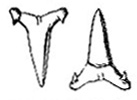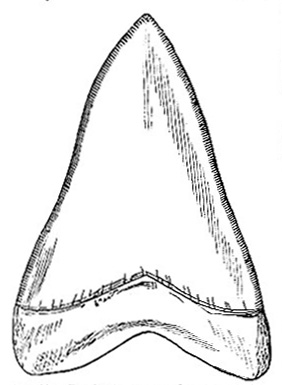1902 Encyclopedia > Shark > Galeocerdo. Hammerheaded Sharks. Porbeagles. Carcharodon.
Galeocerdo is likewise a large shark very dangerous to man, differing from the preceding chiefly by having the outer side of its teeth deeply notched. It has long been known to occur in the North Atlantic, close to Arctic Ocean (G. arcticus), but its existence in other parts has been ascertained within a recent period; in fact, it seems to be one of the most common and dangerous sharks of the Indo-Pacific, the British Museum having obtained specimens from Mauritius, Kurrachee, Madras, and the west coast of Australia.
Hammerheaded Sharks (Zygaena) are sharks in which the anterior portion of the head is produced into a lobe on each side the extremity of which is occupied by the eye. The relation of this unique configuration of the head to the economy of the fish is unknown. Otherwise these sharks resemble Carcharias, and are equally formidable, but seem to be more stationary in their habits. They occur in all tropical and subtropical seas, even in the Mediterranean, where Z. malleus is by no means rare. In the Indian Ocean it is common, and Cantor states that specimens of this species may be often seen ascending from the clear blue depths of the ocean like a great cloud.

Fig. 11 -- Teeth of Lamna shark
The Porbeagles (Lamna) differ from the preceding sharks in their dentition (fig. 11), the teeth being large, lanceolate in shape, not adapted from cutting, but rather for seizing and holding the prey, which consist chiefly in fish. These sharks are therefore not dangerous to man; at least, there is no instance known of a person having been attacked by the species common on the British coast (L. cornubica). It grows to a length of 10 feet, and range to New Zealand and Japan. See vol. xix. p. 518.
To the genus Carcharodon particular interest is attached, because the single still existing species is the most formidable of all sharks, as were those which preceded it in Tertiary times. The existing species (C. rondeletii) occurs in almost all tropical and subtropical seas, but seems to be verging towards extinction. It is known to attain to a length of 40 feet. The tooth figured hereof the natural size (fig. 12) is taken from a jaw much shrunk in drying, but still 20 inches wide in its transverse diameter, and taken from a specimen 36 1/2 feet long.

Fig. 12 -- Tooth of Cacharodon rondeletti
The extinct species must have been still more gigantic in bulk, as we may judge from teeth which are found in the crag or which have been dredged up from the bottom of the Pacific Ocean by the naturalists of the "Challenger" expedition, and which are 4 inches wide at the base and 5 inches long measured along their lateral margin. In some Tertiary strata these teeth are extremely abundant, so much so that -- for instance, in Florida -- the strata in which they occur are quaried to obtain the fossil remains for export to England, where they are converted into artificial manure.
Read the rest of this article:
"Shark" Article - Table of Contents
|

